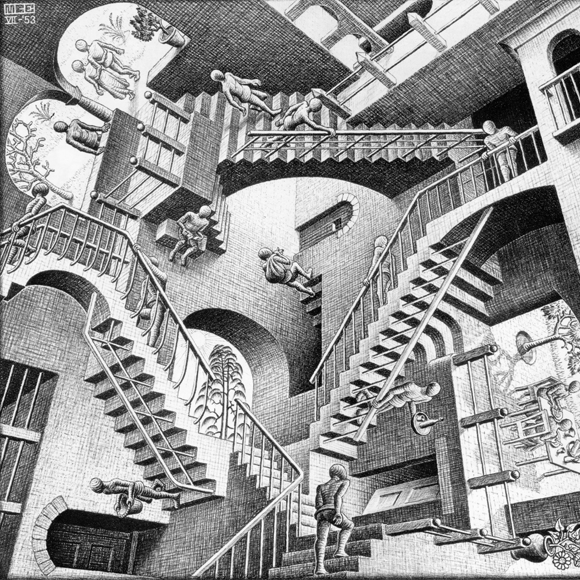escher’s quake
 Stephen [Edwin] King tells us that associating otherwise unrelated ideas in an original way is the key to creating an interesting novel. In a magazine-article he read that paranormal phenomena of the ‘Poltergeist’ kind are prone to appear in the vicinity of adolescent youths. He associated this story with his recollections of some outcast girls who attended school with him. The plot of “Carrie” was born and this novel paved the road to King’s incredible success … are you ready? Are you hanging at the edge of your seat? Not long ago during some quiet moments sitting at the window and wondering at the disturbing beauty of the city at nighttime in winter I suddenly brought together the following three ideas: My fondness of the pictures of M. C. Escher when I still was a kid, the experience of the horizon suddenly spinning clockwise at break-neck speed when I was training for my pilot’s licence, and playing “Quake 3 Arena” (Q3A). Quite unrelated those thoughts, aren’t they? Word has it that Picasso once said, the only thing he regrets is never to have done a graphic novel. If his fellow artist M. C. Escher still would be alive, he might well create a computergame like that:
Stephen [Edwin] King tells us that associating otherwise unrelated ideas in an original way is the key to creating an interesting novel. In a magazine-article he read that paranormal phenomena of the ‘Poltergeist’ kind are prone to appear in the vicinity of adolescent youths. He associated this story with his recollections of some outcast girls who attended school with him. The plot of “Carrie” was born and this novel paved the road to King’s incredible success … are you ready? Are you hanging at the edge of your seat? Not long ago during some quiet moments sitting at the window and wondering at the disturbing beauty of the city at nighttime in winter I suddenly brought together the following three ideas: My fondness of the pictures of M. C. Escher when I still was a kid, the experience of the horizon suddenly spinning clockwise at break-neck speed when I was training for my pilot’s licence, and playing “Quake 3 Arena” (Q3A). Quite unrelated those thoughts, aren’t they? Word has it that Picasso once said, the only thing he regrets is never to have done a graphic novel. If his fellow artist M. C. Escher still would be alive, he might well create a computergame like that:
Imagine a death-match type first person shooter like Q3A. The map you are running through looks like Escher’s “Relativity” or “Another World”. Your enemies are not only running on the floor, but on the walls and ceiling, too. You see an enemy running on a wall. He jumps and in midair he suddenly does half a somersault and lands with his feet on the opposite wall where he continues to run. You try it yourself and you jump as high as you can … and you get sucked to the ceiling where you land on your feet. The former floor is now ceiling to you and vice versa. The experience will be very much like doing aerobatics with a plane. The horizon, and with it the whole gamespace, will suddenly tilt violently, adjusting the player’s view to the new plain of reference when entering its field of gravity. Continuously maintaining a real-time mental representation of the threedimensional gamespace, relative to the player character’s position and orientation will be as challenging a task, as the one a fighter-pilot has to cope with when engaged in a dogfight.
To illustrate the matter have a look at Escher’s “Relativity” above. As a kid I wished, I could throw a ball into this ‘room’, because I wondered how it would behave.
John Carmack, when you read this, feel free to contact me ;-)

